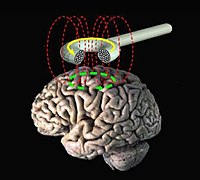
Photo from wikipedia
Minimally invasive transcranial approaches (MITAs) continue to expand in popularity in neurosurgery. Only few MITAs allow sufficient sylvian exposure to enable wide use of the transsylvian corridor. In this study,… Click to show full abstract
Minimally invasive transcranial approaches (MITAs) continue to expand in popularity in neurosurgery. Only few MITAs allow sufficient sylvian exposure to enable wide use of the transsylvian corridor. In this study, we aim to compare the transsylvian corridor in two MITAs: the minipterional (MPTa) and the extended supraorbital eyebrow approaches (XSEa). Eight cadaver heads were used to quantify the surgical exposure and maneuverability along the sylvian fissure and the insular lobe provided by the MPTa and the XSEa. Surgical exposure was calculated by means of the exposed length of the sylvian fissure and by the area framed within three extreme points in the insular lobe. Maneuverability was assessed by means of the surgical freedom along the sylvian cistern. XSEa provides twice the frontal exposure and half of the temporal exposure in comparison to the MPTa (p < 0.001 and p = 0.02, respectively). No significant differences were found between the two craniotomies in the length of the exposure of the sylvian fissure, area of insular exposure, or surgical freedom. Both the MPTa and the XSEa afford sufficient grades of exposure along the sylvian fissure and the insular lobe, although the viewing angle is significantly different between the two approaches. Such properties allow either to be used for microsurgery deep within the sylvian cistern. The use of additional corridors, such as the subfrontal route (XSEa) and pretemporal route (MPTa), may influence selection of either the minipterional or the extended supraorbital approaches according to the origin of the surgical pathology addressed.
Journal Title: Neurosurgical Review
Year Published: 2020
Link to full text (if available)
Share on Social Media: Sign Up to like & get
recommendations!